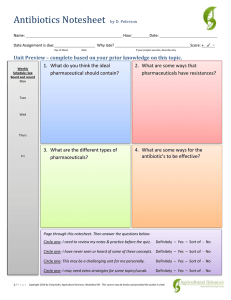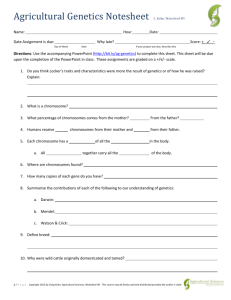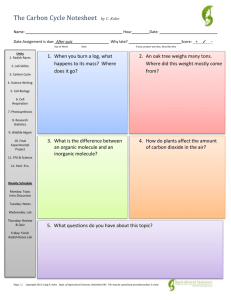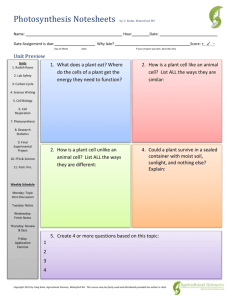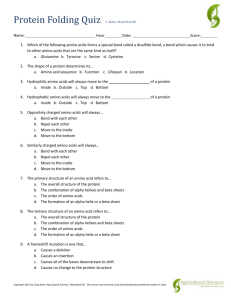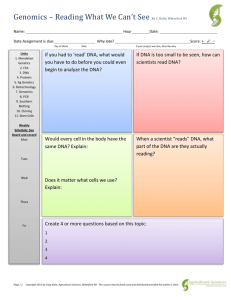Notesheet
advertisement
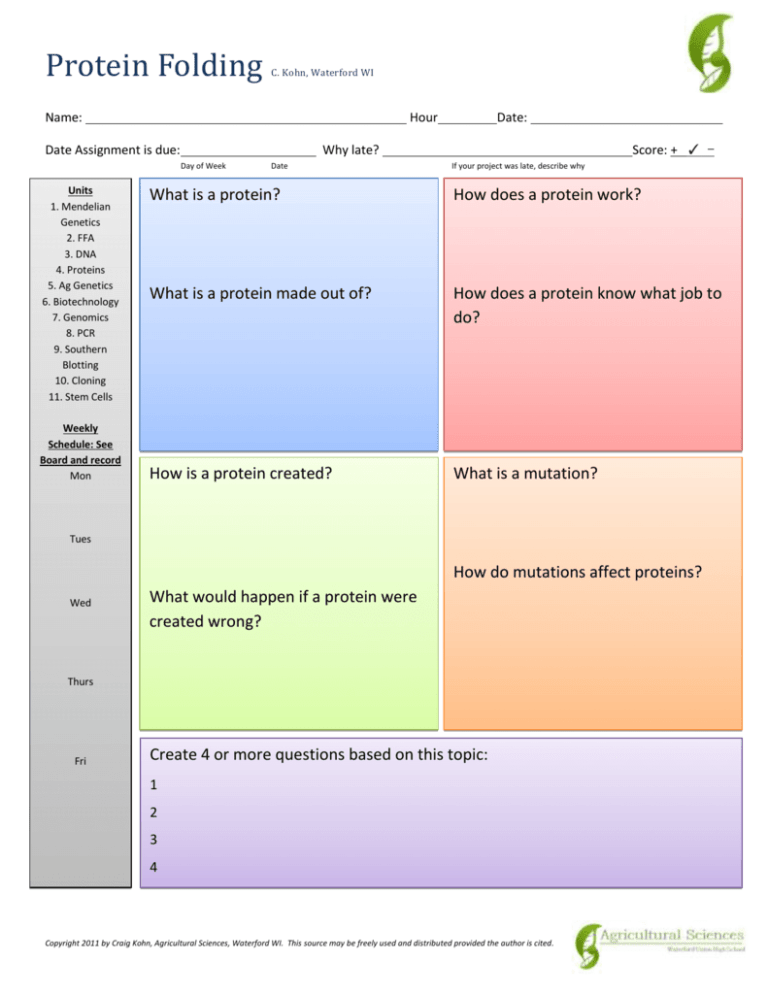
Protein Folding C. Kohn, Waterford WI Name: Hour Date Assignment is due: Weekly Schedule: See Board and record Mon Score: + ✓ - Why late? Day of Week Units 1. Mendelian Genetics 2. FFA 3. DNA 4. Proteins 5. Ag Genetics 6. Biotechnology 7. Genomics 8. PCR 9. Southern Blotting 10. Cloning 11. Stem Cells Date: Date If your project was late, describe why What is a protein? How does a protein work? What is a protein made out of? How does a protein know what job to do? How is a protein created? What is a mutation? Tues How do mutations affect proteins? Wed What would happen if a protein were created wrong? Thurs Fri Create 4 or more questions based on this topic: 1 2 3 4 Copyright 2011 by Craig Kohn, Agricultural Sciences, Waterford WI. This source may be freely used and distributed provided the author is cited. Directions: For the spaces below, look ahead through the notes. Then fill in the boxes below: In 10-20 words, write a sentence explaining what this unit will be about. List 4 or more terms or concepts in this unit that you are already somewhat familiar with. 1. 2. 3. 4. List 4 or more terms or concepts in this unit that you have never seen before or for which have the most limited understanding. 1. 2. 3. 4. List 4 or more concepts or terms that you will find more challenging than others in this unit: 1. 2. 3. 4. Circle one: I have learned some of this material in previous classes. Circle one: I need to review my notes & practice before the quiz. Circle one: I have never seen or heard of some of these concepts. Circle one: This may be a challenging unit for me personally. Definitely – Yes – Sort of - No Definitely – Yes – Sort of - No Definitely – Yes – Sort of - No Definitely – Yes – Sort of - No Copyright 2011 by Craig Kohn, Agricultural Sciences, Waterford WI. This source may be freely used and distributed provided the author is cited. Directions: Use the accompanying PowerPoint (http://bit.ly/protein-ppt) to complete this sheet. This sheet will be due upon the completion of the PowerPoint in class. These assignments are graded on a +/√/- scale. 1. DNA is copied by in a 2. mRNA is read in groups of ( direction ) by a 3. Each codon codes for a specific 4. Each amino acid is delivered by a 5. A string of amino acids creates a and peptides join to form a 6. The shape of a protein comes from its and this shape determines its . 7. Proteins are made from amino acids 8. Each amino acid has a set of that helps to create the shape of the protein a. List some examples of these: 9. What are three ways in which you can identify the amino acid Asparagine? 10. Do amino acids stay in a straight chain after they are assembled? 11. What three kinds of charge can an amino acid have? 12. How does the charge of an amino acid change the way they line up? a. Amino acids with a similar charge will b. Amino acids with opposite charges will Copyright 2011 by Craig Kohn, Agricultural Sciences, Waterford WI. This source may be freely used and distributed provided the author is cited. 13. What is hydrophobicity? 14. Hydrophobic amino acids will 15. Hydrophilic amino acids will 16. In the picture below, label with amino acids are hydrophobic and which are hydrophilic 17. What is a cysteine? 18. Why are cysteines different from other amino acids? 19. What is the bond called between two cysteine molecules? Copyright 2011 by Craig Kohn, Agricultural Sciences, Waterford WI. This source may be freely used and distributed provided the author is cited. 20. In the picture below, circle the cysteine bond 21. In the space below, draw an α helix 22. In the space below, draw a β sheet 23. Describe each of the following levels of protein organization Primary Secondary Tertiary Quaternary Copyright 2011 by Craig Kohn, Agricultural Sciences, Waterford WI. This source may be freely used and distributed provided the author is cited. 24. Define mutation: 25. The effect of a mutation is usually , but it can also be or even have no 26. Mutations are responsible for 27. How do mutations relate to evolution and improvements made through artificial selection in agriculture? _ _ 28. List and describe the four kinds of mutations: 1 2 3 4 29. How can a mutation change an organism (particularly a frameshift mutation)? 30. How does a frameshift mutation change a protein at each level? Primary Secondary Tertiary Quaternary Copyright 2011 by Craig Kohn, Agricultural Sciences, Waterford WI. This source may be freely used and distributed provided the author is cited. Unit Wrap-up C. Kohn, Agricultural Sciences - Waterford WI 1. Write the 3 topics that you most need to review before the quiz: 1_ 2_ 3_ 2. Create 3 high-level questions related to this material (These questions could be something you still don’t know or questions that reflect understanding that you have now that you did not have before.) 1_ 2_ 3_ 3. List 6 vocabulary words that you did not know before or have almost never used before: 1_ 2 3 4 5 6 4. Create a strategy that you have for remembering a specific item from this unit _ ☆NOTE: A strategy is not an activity such as reviewing your notes, making cards, studying hard, etc. A strategy is a mnemonic, rhyme, analogy, or other brain-based device. 5. Create a second different strategy that you have for remembering a specific item from this unit? _ 6. Create a third different strategy that you have for remembering a specific item from this unit _ 7. Complete this question after the quiz. Circle the most appropriate response. You will only be graded on whether or not you completed this section, so be entirely honest with yourself when completing this section. Circle one: I used my notes outside of class to prepare for the quiz. Definitely – Yes – Sort of - No Circle one: I took extra notes in the margins for very difficult concepts. Definitely – Yes – Sort of - No Circle one: I created a personal strategy for at least two difficult items. Definitely – Yes – Sort of - No Circle one: I was very involved and actively studying during the quiz review. Definitely – Yes – Sort of - No Circle one: I am happy or satisfied with the quiz grade I received this week. Definitely – Yes – Sort of - No Copyright 2011 by Craig Kohn, Agricultural Sciences, Waterford WI. This source may be freely used and distributed provided the author is cited.
